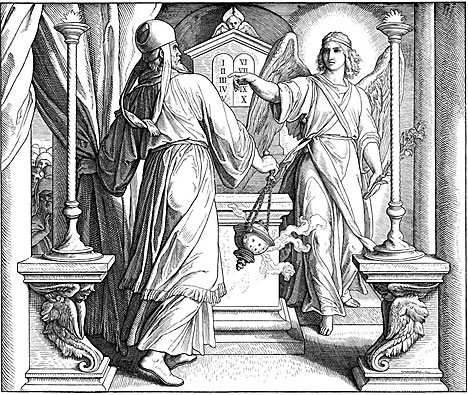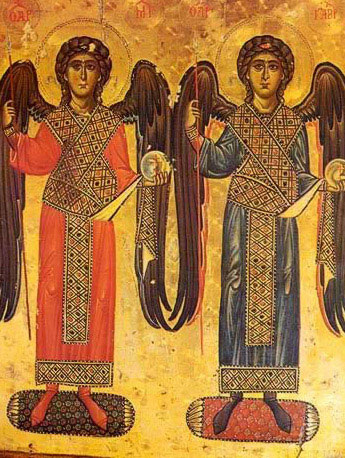May
9
2013
 The first verses of 2 Thessalonians 2 have been an unnecessary battle ground. The Day of the Lord would not come until after the Man of Sin had been revealed. This reasoning seems obvious to Paul. It should be obvious to us if we know the early chapters of Genesis and their corporate expression in Israel’s festal calendar.
The first verses of 2 Thessalonians 2 have been an unnecessary battle ground. The Day of the Lord would not come until after the Man of Sin had been revealed. This reasoning seems obvious to Paul. It should be obvious to us if we know the early chapters of Genesis and their corporate expression in Israel’s festal calendar.
Continue reading
Comments Off | tags: AD70, Covenant Theology, Feasts, Firstfruits, Genesis | posted in Bible Matrix, Biblical Theology, The Last Days
Apr
8
2013
 Part 1 | Part 2 | Part 3 | Part 4 | Part 5
Part 1 | Part 2 | Part 3 | Part 4 | Part 5
We have reached the fifth stage of the matrix in Paul’s letter to the Ephesians, which is the sixth cycle (as discussed in part 5, stage 3 — Ascension — is often split into two parts, altar and sacrifice).
So this fifth section is the “Deuteronomy” of the epistle. It is a New Covenant version of Moses giving his final words to the children of Israel before the conquest of the Land. Likewise, Paul himself, and all the other apostles (except perhaps for John, the final word) would be gone before the rulers of the Land (Revelation’s “kings of the earth”) would be wiped off the face of it forever.
As in all previous cycles, there are some real literary wonders here, which is especially satisfying to see when the passages themselves (unparsed) are so familiar. It’s like seeing old friends in a new way: the letter resurrected and alive and walking around.
Continue reading
Comments Off | tags: Covenant Theology, Daniel, Ephesians, Feasts, Literary Structure | posted in Bible Matrix, Biblical Theology
Mar
31
2013
Covenant Structure in Judges 14-15:8

“I will open my mouth in a parable;
I will utter dark sayings from of old… “
Psalm 78:2
The account of Samson’s marriage and the subsequent collateral damage is one of those stories out of which teachers and preachers try in vain to wring a moral. After all, isn’t that what the Old Testament is for? Actually, no. It is a history of God’s Covenants, and every single text, whether historical narrative or prophetic vision, has a Covenant structure. Certainly, there are morals, but some stories resist such an obvious use (unless we are willing to cook the Book). These stories of God’s delegated authorities are intended to illustrate the work of God in the world.
Continue reading
Comments Off | tags: Covenant Theology, Feasts, Judges, Literary Structure, Samson | posted in Bible Matrix, Biblical Theology
Dec
26
2012

Here’s some interesting calculations concerning the day of Jesus’ birth in relation to Israel’s festal calendar. It was written by Michael Scheifler (a Seventh-day Adventist), and is reproduced here with his permission.
While much of the world celebrates the birth of Jesus Christ on the 25th of December, can the actual day of Jesus’ birth be determined from scripture? This question will be explored in some detail, and will yield a result that is quite intriguing. The first passage we will consider begins with the father of John the Baptist, Zacharias:
Continue reading
Comments Off | tags: 70 Weeks, Bible Chronology, Booths, Christmas, Chronicles, Daniel, Feasts, Luke, Tabernacles, Temple | posted in Biblical Theology, Quotes, The Last Days
Dec
21
2012

Part 1 | Part 2 | Part 3 | Part 4 | Part 5 | Part 6
Sacred Geometry and Marked Men
Chapters 35-36 bring us to the end of this structural analysis of the book of Numbers. The position of this final cycle is in red.
Overview of Numbers
Genesis/Transcendence – Creation:
1 – Israel called and arranged as a New Creation
Exodus/Hierarchy – Division/Delegation/Passover:
2 – Leadership disputes, failures and judgments
Leviticus/Ethics Given – Ascension/Firstfruits/Altar:
3 – Levitical offerings and “firstfruits” victories
Numbers/Ethics Opened – Testing/Pentecost:
4 – Israel fails the jealous inspection
Deuteronomy/Ethics Received – Maturity/Trumpets:
5 – Israel’s national festal offerings
Joshua/Sanctions – Atonement/Vindication:
6 – Vengeance upon Midian, Dividing the Land
Judges/Succession – Booths/Glory
7 – Cities of Refuge; Marriage of Female Heirs
Continue reading
Comments Off | tags: Feasts, Jubilee, Literary Structure, Moses, Numbers, Tabernacle | posted in Bible Matrix, Biblical Theology, The Last Days
Dec
1
2012
Shedding Blood in the Dark: The Liturgical Shape of Skyfall
 [This post contains detailed spoilers.]
[This post contains detailed spoilers.]
James Bond: Everybody needs a hobby.
Silva: So, what’s yours?
James Bond: Resurrection.
In the late 60s and early 70s, the structures of traditional Western storytelling were deliberately omitted from “thinking” films. Bleak narratives reflected the randomness of life without faith. Movies were becoming formless and void.
Continue reading
2 comments | tags: Feasts, Film, Literary Structure, Moses, Steven Opp | posted in Bible Matrix, Biblical Theology
Oct
26
2012

“Israel’s ministry was to purchase every single day with blameless blood. Every morning and evening enjoyed by the nations was paid for in Yahweh’s name.”
Part 1 | Part 2 | Part 3 | Part 4
After the spectacular stories of Balaam and Phinehas, it is no wonder the modern mind has problems when the Torah suddenly crunches its gears to speak once again in detail about offerings. To the higher critic, this is simply evidence of a hodgepodge of scrolls gathered together by an ignorant and hurried scribe. For the believer, it adds to the niggling sense that the Bible has an internal logic which neither your pastor nor any Christian book you have read so far seems to be able to solve, despite many valiant attempts.
Continue reading
Comments Off | tags: David A. Dorsey, Feasts, Numbers | posted in Bible Matrix, Biblical Theology
Aug
30
2012
Theandric Plenipotentiary Iteration
 “It takes on form like clay under a seal…” (Job 38:14)
“It takes on form like clay under a seal…” (Job 38:14)
Read The Secret before you read this post.
Typology is the science of recognizing the shape of one thing stamped upon, into, something else. In itself, this is not an exact science by any means, and is prone to abuse. Thankfully, the Bible doesn’t simply give us isolated “indentations”; it gives them to us in sequences. Sequences of ideas, like sequences of musical notes, are exact, even if our identification of them is not yet as refined as we would like.
[This post has been refined and included in Sweet Counsel: Essays to Brighten the Eyes.]
Continue reading
Comments Off | tags: Chiasm, Feasts, Genesis, Literary Structure, Mark Horne, Revelation | posted in Bible Matrix, Biblical Theology, Creation, The Last Days
Aug
22
2012

And every pot in Jerusalem and Judah shall be holy to the Lord of hosts, so that all who sacrifice may come and take of them and boil the meat of the sacrifice in them. (Zechariah 14:21)
Working on a post about the use of seals in Revelation, I was looking through the uses of the word “seal” throughout the Bible. Daniel 9:24, a very famous verse, showed up, and its structure struck me as worth some analysis. If structure is indeed part of the means of the Author’s communication, it is not an optional extra.
Continue reading
Comments Off | tags: AD70, Covenant curse, Covenant Theology, Daniel, Feasts, James Jordan, Levites, Leviticus, Literary Structure, Peter Leithart | posted in Bible Matrix, Biblical Theology, The Last Days, The Restoration Era
Jul
25
2012

God Has You Covered
Parsing Psalms means consulting the Hebrew for the word order. This one was quite difficult, once again because English translations mess with things, and also because the Hebrew author likes to play with the matrix structures to make a point. I find I have to redo sections and keep shaking it up until it all falls into place. Is this sentence part of the previous stanza or the beginning of a new one? Or does this stanza have one line that gets expanded into its own pattern to make a point?
The good thing is that once it shakes out, there are some beautiful surprises. One of the gems in this Psalm is the sentence concerning the sun and the moon. In English it is simply two lines (a parallelism), but in Hebrew it is chiastic. Wonderful.
Continue reading
4 comments | tags: Chiasm, Feasts, Literary Structure, Psalms, Tabernacle, Tabernacles | posted in Bible Matrix, Biblical Theology
 The first verses of 2 Thessalonians 2 have been an unnecessary battle ground. The Day of the Lord would not come until after the Man of Sin had been revealed. This reasoning seems obvious to Paul. It should be obvious to us if we know the early chapters of Genesis and their corporate expression in Israel’s festal calendar.
The first verses of 2 Thessalonians 2 have been an unnecessary battle ground. The Day of the Lord would not come until after the Man of Sin had been revealed. This reasoning seems obvious to Paul. It should be obvious to us if we know the early chapters of Genesis and their corporate expression in Israel’s festal calendar.

































